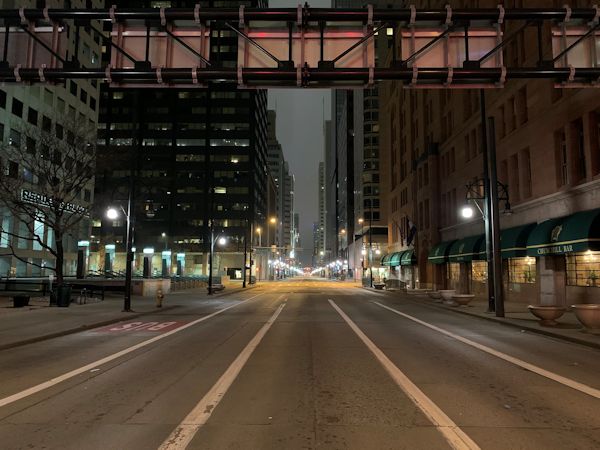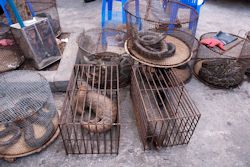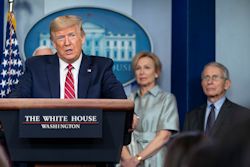SEJournal Online is the digital news magazine of the Society of Environmental Journalists. Learn more about SEJournal Online, including submission, subscription and advertising information.
 |
| Since many U.S. commuters have stopped driving during the COVID-19 outbreak, carbon emissions in the country have plummeted. Above, empty streets in Denver on March 15. Photo: Jesse James, Flickr Creative Commons. Click to enlarge. |
Backgrounder: Coronavirus Pandemic Spawns Many Stories on Environment Beat
By Joseph A. Davis
For journalists reporting about coronavirus/COVID-19, the main story — the reason it is top news — is the viral pandemic that is killing people all over the world. That said, COVID-19, along with its causes and consequences, is also a major story for the environment and energy beats.
Journalists of all flavors have been busy writing about that. And you can, too. But your audience will be well served if you don’t stretch the environment and energy connection too far just to tag along on a top story.
Still, many journalists have drawn connections between the COVID-19 story and the other big environment story, climate. The important links involve collective denial of a looming public disaster and failure to take effective action in time to minimize and respond to it.
But does climate change cause outbreaks like this? That’s more of a stretch. Environmental Health News and InsideClimate News interviewed Dr. Aaron Bernstein of Harvard’s T.H. Chan School of Public Health. Bernstein noted that some of the same root causes of climate change — deforestation, industrial farming, habitat loss and other environmental disruptions — can cause or worsen outbreaks.
True enough. And public health experts have been warning for a long time that climate change can expand and move populations of disease vectors like mosquitos or ticks.
In a New York Times article (may require subscription), Somini Sengupta cited the World Health Organization’s concern over “alarming levels of inaction” on COVID-19. It’s a twice-told tale for those who have been covering climate change. Politics and psychology play big roles in society’s denial of problems and delay of solutions.
Nevertheless, there are many environment and energy angles on the COVID-19 story and much multifaceted coverage already. So it may be helpful to look at it using a large set of categories.
Connection to other respiratory disease
Clinical experience with COVID-19 has suggested that complications and fatalities are likelier in patients with preexisting “underlying conditions” (may require subscription). That may include suppressed immune systems, heart disease, diabetes, high blood pressure and a range of lung ailments like various forms of asthma, pulmonary hypertension or chronic obstructive pulmonary disease, better known as COPD.
Some of these lung ailments are commonly caused by, or aggravated by, the inhalation of atmospheric pollution. This is one reason why Congress passed the Clean Air Act and the U.S. Environmental Protection Agency regulates air pollution.
If you live in an area where elevated
air pollution causes more lung disease,
you may find a COVID-19 angle. Or not.
For example, lungs that are damaged or weakened by air pollution like smog are more likely to contract pneumonia. Pneumonia is actually a range of types of lung infections, whether by viruses, bacteria or fungi, that can be life-threatening, especially in the very young and very old. The people who die of COVID-19 very often contract pneumonia, which worsens and creates complications which kill them.
Air pollution, indoor and outdoor, kills an estimated seven million people worldwide per year according to the World Health Organization. So if you live in an area where elevated air pollution causes more lung disease, you may find a COVID-19 angle. Or not. At this time of year, air pollution is not so bad. It will be different in cities like the Indian capital of Delhi, where pollution is chronically awful — or a place where indoor wood cookstoves are common. Or a place where more people smoke.
Washington Post environment reporter Chris Mooney did a deep dive (may require subscription) on this question earlier in March. While lots of scientists are looking at possible connections between bad air and worsened COVID-19, he noted, most are still waiting for more conclusive proof of causality. You can find other stories on this same question in the Guardian, the Verge and Forbes.
Temporary drop in emissions
The lockdowns and suspensions of economic activity all over the world in response to COVID-19 have resulted in drastic lessening of pollution. The response to the pandemic has been especially hard on the airline industry, which is one reason why we have seen drops in carbon dioxide, a greenhouse gas.
But the reduction is seen among many pollutants, across industries. Using monitoring satellites over China, for example, NASA scientists could see drops in nitrogen dioxide (a component of smog) soon after the quarantine there began. Since people stopped driving to work and going to school in the United States, emissions have plummeted in this country (may require subscription) as well.
“Silver linings” keep our spirits up in the
middle of disaster. But the pollution will
bounce back with gusto when quarantines end.
It would be easy to make too much of this effect. It is the “silver lining” of a very dark and destructive cloud. “Silver linings” keep our spirits up in the middle of disaster. But the pollution will bounce back (may require subscription) with gusto when quarantines end.
Certainly, it’s a practical demonstration that less driving, for example, means less pollution. But we already knew that. And there is the danger that as pollution problems get temporarily less acute, we will feel less urgency about implementing long-term fixes.
This problem may especially occur with the carbon dioxide emissions that are the principal driver of climate change worldwide. Many have worried already that the pandemic crisis could stall action on the climate crisis and urged nations not to let this happen.
Oil price crash
Headline writers have come easily to blaming the COVID-19 pandemic for the crash of crude oil prices and seeming blow-up of the crude oil (and gas) market.
There is much reason for this. A major slackening of demand for oil products followed the sudden downturn in economic activity that sped up once the virus had hit Wuhan, China. Drastic cutbacks in air travel made it worse. As other parts of the world stopped economic activity to combat the virus, demand slid further and inventories built up (which depresses prices).
But don’t oversell it. Oil was struggling to maintain its price even before the Wuhan outbreak. A major cataclysm happened on March 5 (may require subscription) when OPEC efforts to win production cuts from its sometime partner Russia collapsed. Saudi Arabia, the 900-pound gorilla (and swing producer) declared an oil price war (may require subscription) aimed at bringing Russia to heel.
It hasn’t worked so far. Oil was selling at $22 per barrel later in the month. Many observers think an added motive for both Saudi and Russia is to drive already-strapped U.S. frackers off the playing field and out of the market.
The oil and gas industry is ready and eager to take advantage of the crisis to get various bailouts during these hard times. The Trump administration is glad to help. For instance, it is moving with its existing authority to buy crude oil (may require subscription) to refill the Strategic Petroleum Reserve. Ironically, the administration had only months before in its 2021 budget proposal called for selling off oil in the reserve to get revenue.
This may not be the end of it, though. The industry is still hoping for more aid in the big COVID-19 aid bill that is pending in Congress — something Democrats are opposing.
 |
| Caged pangolins at an illicit wildlife market in Myanmar in 2008. Pangolins may have been the intermediate species that transmitted the novel coronavirus from animals, possibly bats, to humans. Photo: Dan Bennett, Wikimedia Commons. Click to enlarge. |
Possible zoonotic origins
Some experts have speculated that the COVID-19 virus jumped from bats, possibly to an intermediate species (perhaps pangolins) and then to humans. The evidence to support this theory is lodged in the genome of the virus itself — plus precedent. But the story remains murky.
Yes, viruses similar to COVID-19 have been seen in Chinese horseshoe bats (and no, it was not engineered in the lab as a bioweapon by a hostile power). The deadly SARS that swept parts of China in 2002 was also a coronavirus, also believed to have originated in bats (but, importantly, to have traveled via intermediate species). On COVID-19, the jury is still out.
This narrative was complicated by the story of the “wet market” in Wuhan (may require subscription). Some Chinese like to consume exotic animal species and also like to buy their meat alive or freshly slaughtered. Wet markets feature such meats, and the COVID-19 virus was believed to have originated (may require subscription) at the one in Wuhan.
Closing of the market, however, ended hopes for forensic investigation. Chinese authorities have cracked down on such markets, at least for now. These types of crowded environments are not only incubators for animal transmission of viruses, but also for human-to-human transmission.
Few people see them objectively. Chinese culture and traditions assign positive value to them. But Westerners bring their own political agendas to the discussion, whether radical animal rights activists or racist-tinged conservatives.
If any of this is true, COVID-19 may be a special case of a much broader phenomenon of animal-to-human transmission of disease, a process called zoonosis.
Zoonotic diseases should be an important part of the environment beat — they provide a large collection of really interesting stories. Some zoonotic diseases, like the bubonic plague, flare up when humans disturb the boundaries between wild areas and human settlement. Others, like Ebola and HIV-AIDS, jump the species barrier and continue via human-to-human transmission.
In the end, humans may be as much to blame for these diseases as animals.
Disaster preparedness and prevention
Events have proven that U.S. preparedness for the COVID-19 had been far less than it could or should have been. That’s what’s in the latest headlines: lack of beds, masks, ventilators … and plans.
The viral pandemic is just one of many public health disasters and emergencies that the environment beat throws at journalists regularly: wildfires, tornadoes, hazmat spills, toxic leaks, fertilizer explosions, floods, water contamination, food contamination, radiation releases and more.
All of it is predictable enough to prepare for. All of it is needing to be covered, ideally, before it happens.
SEJournal Online recently published a TipSheet to help reporters prepare and handle such emergencies. Now let’s hope the government gets its act together, too.
 |
| How science informs policy has come into stark relief at regular White House press briefings on COVID-19. Above, President Trump and members of the White House Coronavirus Task Force, including Dr. Anthony Fauci, far right, at a March 20 briefing. Photo: White House/Shealah Craighead. Click to enlarge. |
Science denial
The daily White House news conferences on the pandemic have only made clearer the problem of bringing sound science to bear on life-or-death public policy decisions. This is a problem that folds in not only public health and global warming, but also many of the scientific judgments involved in protecting environmental health. It is a live-fire battleground.
For weeks, President Trump publicly dismissed the COVID-19 pandemic as a “hoax” ginned up by his political enemies to harm him, using the bully pulpit to deny what was clearly understood by health scientists.
The issue of how science informs policy came into stark relief March 19-20, when Trump began pushing the malaria drug hydroxychloroquine as a treatment for COVID-19, despite public statements by scientists (including Dr. Anthony Fauci, head of the National Institute of Allergy and Infectious Diseases) that there was no evidence to support its effectiveness. Pressed by reporters, Trump hurled insults and said it was “just a feeling.”
Time will tell whether Trump’s apparent disdain for science has a disastrous toll. But throughout his administration, especially on the environment beat, it has been a serious and festering issue.
It was not simply that he called climate change (on which there is scientific consensus) a Chinese “hoax” before taking office. In the very first year of his administration, his EPA chief overruled the agency’s scientists (may require subscription) to allow use of chlorpyrifos, a pesticide linked to brain damage in kids.
And when confronted with the Nov. 2018 “National Assessment” on climate change prepared by his own federal agencies, which concluded that it would do grave harm to the U.S. economy, Trump said “I don’t believe it.”
Meanwhile, his agencies have been busy “suppressing” relevant scientific evidence used in regulatory decisions and deleting mention of climate from agency documents. It has added up to what critics call a “war on science” (may require subscription).
Political fallout, aid legislation
Political and legislative reporters are less likely to worry about COVID-19 as an illness than they are about the economic and political disaster it also presents. Their story focus is the huge, trillion-dollar aid package Congress and the White House were cooking up.
Even there, environment and energy angles are everywhere.
Currently, there are three COVID-19 rescue packages, two of them already passed by Congress and signed by Trump. The first, signed March 6, was worth about $8 billion. The second, signed March 19, focused on things like free testing and some paid emergency leave, and was worth about $100 billion.
As to the third, word emerged early March 25 of a “deal” reached by Senate and White House negotiators on a nearly $2 trillion aid package. Details initially were sketchy about energy and environmental aspects of the measure, with bill watchers looking for news about oil reserves, emergency transit funding, cuts in airline carbon emissions, clean energy tax credits, and relief for oil, gas and coal industries.
Read more about the measure in this special edition TipSheet. And stay tuned to SEJ.org as SEJournal Online continues to report developments and EJ Today tracks daily headlines.
Joseph A. Davis is a freelance writer/editor in Washington, D.C. who has been writing about the environment since 1976. He writes SEJournal Online's TipSheet, Reporter's Toolbox and Issue Backgrounder, as well as compiling SEJ's weekday news headlines service EJToday. Davis also directs SEJ's Freedom of Information Project and writes the WatchDog column and WatchDog Alert.
* From the weekly news magazine SEJournal Online, Vol. 5, No. 12. Content from each new issue of SEJournal Online is available to the public via the SEJournal Online main page. Subscribe to the e-newsletter here. And see past issues of the SEJournal archived here.














 Advertisement
Advertisement 



